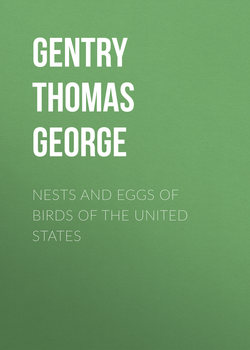Nests and Eggs of Birds of The United States

Реклама. ООО «ЛитРес», ИНН: 7719571260.
Оглавление
Gentry Thomas George. Nests and Eggs of Birds of The United States
Preface
Plate I. – AMPELIS CEDRORUM, Sclater. – Cedar-Bird
Plate II. – CONTOPUS VIRENS, Cabanis. – Wood Pewee
Plate III. – MIMUS. CAROLINENSIS, Gray. – Cat-Bird
Plate IV. – ICTERUS SPURIUS, Bonaparte. – Orchard Oriole
Plate V. – TYRANNUS CAROLINENSIS, Baird. – Kingbird
Plate VI. – AGELAIUS PHOENICEUS, Vieillot. – Redwing Blackbird
Plate VII. – TROCHILUS COLUBRIS, Linaeus. – Ruby-throated Humming-bird
Plate VIII. – PIPILO ERYTHROPHTIIALMUS, Vieillot. – Towhee Bunting
Plate IX. – PICUS PUBESCENS, Linaeus. – Downy Woodpecker
Plate X. – VIREOSYLVIA OLIVACEUS, Bonaparte. – Red-eyed Vireo
Plate XI. – TRINGOIDES MACULARIUS, Gray. – Spotted Sandpiper
Plate XII. – SPIZELLA SOCIALIS, Bonaparte. – Chipping Sparrow
Plate XIII. – PYRANGA RUBRA, Vieillot. – Scarlet Tanager
Plate XIV. – HIRUNDO HORREORUM, Barton. – Barn Swallow
Plate XV. – LOPHORTYX CALIFORNICA, Bonaparte. – The Valley Quail of California
Plate XVI. – REGULUS SATRAPA, Licht. – Golden-crowned Kinglet
Plate XVII. – UTAMANIA TORDA, (Linn.), Leach. – Razor-billed Auk
Plate XVIII. – DENDROECA DISCOLOR, Baird. – Prairie Warbler
Plate XIX. – ZENAIDURA CAROLINENSIS, (Linn.) Bonaparte. – Mourning Dove
Plate XX. – TINNUNCULUS SPARVERIUS, (Lnn.) Vieillot. – Sparrow Hawk
Plate XXI. – AIX SPONSA, (Linn.) Boie. – Wood Duck; Summer Duck
Plate XXII. – PSALTRIPARUS MINIMUS, (Townsend) Bonaparte. – Least Tit
Plate XXIII. – CAPRIMULGUS VOCIFERUS, Wilson. – Whippoorwill
Plate XXIV. – PHILOHELA MINOR, (Gmel.) Gray. – American Woodcock
Plate XXV. – COLYMBUS SEPTENTRION A LIS, Linnæus. – Red-throated Diver
Plate XXVI. – POLIOPTILA CÆRULEA, (Linn.) Sclater. – Blue-gray Gnatcatcher
Plate XXVII. – PASSERINA CIRIS, (Linn.) Gray. – Nonpareil; Painted Bunting
Plate XXVIII. – CERYLE ALCYON, (Linn.) Boie. – Belted Kingfisher
Plate XXIX. – BONASA UMBELLUS, (Linn.) Stephens. – Ruffed Grouse
Plate XXX. – STERNA ANTILLARUM, (Less.) Coues. – Least Tern
Plate XXXI. – SIALIA SIALIS, (Linn.) Haldem. – Eastern Bluebird
Plate XXXII. – SETOPHAGA RUTICILLA, (Link.) Swainson. – American Redstart
Plate XXXIII. – SCOPS ASIO, (Linn.) Bonaparte. – Mottled Owl
Plate XXXIV. – RALLUS VIRGINIANUS, Linn. – Virginia Rail
Plate XXXV. – GEOTHLYPIS TRICHAS, (Linn.) Caban. – Maryland Yellow-Throat
Plate XXXVI. – SITTA CAROLINENSIS, Gmelin. – White-bellied Nuthatch
Plate XXXVII. – MELEAGRIS GALLOPAVO VAR. AMERICANA, (Bartr.) Coues. – Wild Turkey
Plate XXXVIII. – CHÆTURA PELASGICA, (Linn.) Baird. – Chimney Swift
Plate XXXIX. – OXYECHUS VOCIFERUS, (Linn.) Reich. – Killdeer
Plate XL. – QUISCALUS PURPUREUS, (Bartram) Licht. – Purple Grackle
Plate XLI. – ASTRAGALINUS TRISTIS, (Linn.) Cab. – American Goldfinch
Plate XLII. – BUTORIDES VIRESCENS, (Linn.) Baird. – Green Heron
Plate XLIII. – CYANOCITTA CRISTATA, (Linn.) Strickl. – Blue Jay
Plate XLIV. – TELMATODYTES PALUSTRIS, (Wils.) Baird. – Long-billed Marsh Wren
Plate XLV. – COCCYZUS AMERICANUS, (Linn.) Bp. – Yellow-billed Cuckoo
Plate XLVI. – ICTERIA VIRENS, (Linn.) Baird. – Yellow-breasted Chat
Plate XLVII. – HÆMATOPUS PALLIATUS, Temm. – American Oystercatcher
Plate XLVIII. – CATHARTES AURA, (Linn.) Illig. – Turkey Buzzard
Plate XLIX. – LOPHODYTES CUCULLATUS, (Linn.) Reich. – Hooded Sheldrake
Plate L. – PHAINOPEPLA NITENS, (Sw.) Scl. – Black-crested Flycatcher
Отрывок из книги
The Cedar-Bird, though mainly a denizen of the wooded regions of North America, and occasionally of cultivated fields and orchards, has been known to nest from Florida to the Red River country. But, wherever found during the non-breeding period, it is the same gregarious, nomadic species.
After the beginning of October, the search for food so completely engrosses the attention, that it is not until the latter part of May, or the beginning of June, that the flocks break up into pairs.
.....
The love for offspring is very intense, and manifests itself in unwearied devotion, and the tenderest solicitude. From early morn until dusk, one parent or the other is constantly on the go for appropriate articles of fare. Usually but one is absent at a time on this important business. But the demands for food are so pressing, that both are sometimes compelled to leave home, but only for a short time, and then never beyond seeing distance of the nest. At first the young are fed upon smooth caterpillars, aphides, spiders, ants, butterflies, and dipterous insects; but as they mature, small beetles and other hard-shelled articulates are added to their varied and extensive menu. At the age of fifteen days, they quit the nest, receive instructions in ærial navigation under the tutorage of the paternal head, and in ten days more, are prepared to shift for themselves.
One peculiarity of this species must have struck the attention of every careful observer of its habits; that is, its remarkable sociability. Audubon cites a case where no less than nine pairs were found breeding in the same enclosure. We have known instances where as many as five nests, all occupied, were crowded in the same orchard, within a short distance of each other. The most perfect good feeling and harmony prevailed in this little colony, the birds mingling together with the freedom and ease of inhabitants of the best regulated human communities.
.....